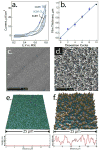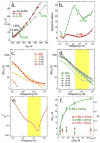Virus-poly(3,4-ethylenedioxythiophene) composite films for impedance-based biosensing
- PMID: 21388148
- PMCID: PMC3069217
- DOI: 10.1021/ac2000835
Virus-poly(3,4-ethylenedioxythiophene) composite films for impedance-based biosensing
Abstract
Composite films composed of poly(3,4-ethylenedioxythiophene), PEDOT, and the filamentous virus M13-K07 were prepared by electrooxidation of 3,4-ethylenedioxythiophene (EDOT) in aqueous solutions containing 8 nM of the virus at planar gold electrodes. These films were characterized using atomic force microscopy and scanning electron microscopy. The electrochemical impedance of virus-PEDOT films increases upon exposure to an antibody (p-Ab) that selectively binds to the M13 coat peptide. Exposure to p-Ab causes a shift in both real (Z(RE)) and imaginary (Z(IM)) impedance components across a broad range of frequencies from 50 Hz to 10 kHz. Within a narrower frequency range from 250 Hz to 5 kHz, the increase of the total impedance (Z(total)) with p-Ab concentration conforms to a Langmuir adsorption isotherm over the concentration range from from 6 to 66 nM, yielding a value for K(d) = 16.9 nM at 1000 Hz.
Figures



Similar articles
-
Virus-Enabled Biosensor for Human Serum Albumin.Anal Chem. 2017 Jan 17;89(2):1373-1381. doi: 10.1021/acs.analchem.6b04840. Epub 2017 Jan 3. Anal Chem. 2017. PMID: 27989106 Free PMC article.
-
Virus-poly(3,4-ethylenedioxythiophene) biocomposite films.Langmuir. 2012 Aug 28;28(34):12581-7. doi: 10.1021/la302473j. Epub 2012 Aug 16. Langmuir. 2012. PMID: 22856875 Free PMC article.
-
Virus-PEDOT nanowires for biosensing.Nano Lett. 2010 Dec 8;10(12):4858-62. doi: 10.1021/nl1025826. Epub 2010 Nov 1. Nano Lett. 2010. PMID: 21038915 Free PMC article.
-
Applications of poly(3,4-ethylenedioxythiophene) doped with poly(styrene sulfonic acid) transistors in chemical and biological sensors.Chem Rec. 2008;8(1):13-22. doi: 10.1002/tcr.20133. Chem Rec. 2008. PMID: 18302284 Review.
-
Methods of poly(3,4)-ethylenedioxithiophene (PEDOT) electrodeposition on metal electrodes for neural stimulation and recording.J Neural Eng. 2023 Jan 31;20(1). doi: 10.1088/1741-2552/acb084. J Neural Eng. 2023. PMID: 36603213 Review.
Cited by
-
Sub-nanomolar detection of prostate-specific membrane antigen in synthetic urine by synergistic, dual-ligand phage.J Am Chem Soc. 2013 May 22;135(20):7761-7. doi: 10.1021/ja4028082. Epub 2013 May 13. J Am Chem Soc. 2013. PMID: 23614709 Free PMC article.
-
Virus-Enabled Biosensor for Human Serum Albumin.Anal Chem. 2017 Jan 17;89(2):1373-1381. doi: 10.1021/acs.analchem.6b04840. Epub 2017 Jan 3. Anal Chem. 2017. PMID: 27989106 Free PMC article.
-
Chemically Modifying Viruses for Diverse Applications.ACS Chem Biol. 2016 May 20;11(5):1167-79. doi: 10.1021/acschembio.6b00060. Epub 2016 Mar 21. ACS Chem Biol. 2016. PMID: 26930417 Free PMC article. Review.
-
The Virus Bioresistor: Wiring Virus Particles for the Direct, Label-Free Detection of Target Proteins.Nano Lett. 2018 Jun 13;18(6):3623-3629. doi: 10.1021/acs.nanolett.8b00723. Epub 2018 May 9. Nano Lett. 2018. PMID: 29718676 Free PMC article.
-
Viruses Masquerading as Antibodies in Biosensors: The Development of the Virus BioResistor.Acc Chem Res. 2020 Oct 20;53(10):2384-2394. doi: 10.1021/acs.accounts.0c00474. Epub 2020 Oct 1. Acc Chem Res. 2020. PMID: 33001632 Free PMC article.
References
-
- Petrenko V, Vodyanoy V. Journal of Microbiological Methods. 2003;53:253–262. - PubMed
-
- Nanduri V, Balasubramanian S, Sista S, Vodyanoy VJ, Simonian AL. Analytica Chimica Acta. 2007;589:166–172. - PubMed
-
- Nanduri V, Sorokulova IB, Samoylov AM, Simonian AL, Petrenko VA, Vodyanoy V. Biosensors & Bioelectronics. 2007;22:986–992. - PubMed
-
- Olsen E, Sorokulova I, Petrenko V, Chen I, Barbaree J, Vodyanoy V. Biosensors & Bioelectronics. 2006;21:1434–1442. - PubMed
-
- Weiss GA, Penner RM. Analytical Chemistry. 2008;80:3082–3089. - PubMed
Publication types
MeSH terms
Substances
Grants and funding
LinkOut - more resources
Full Text Sources
Other Literature Sources

